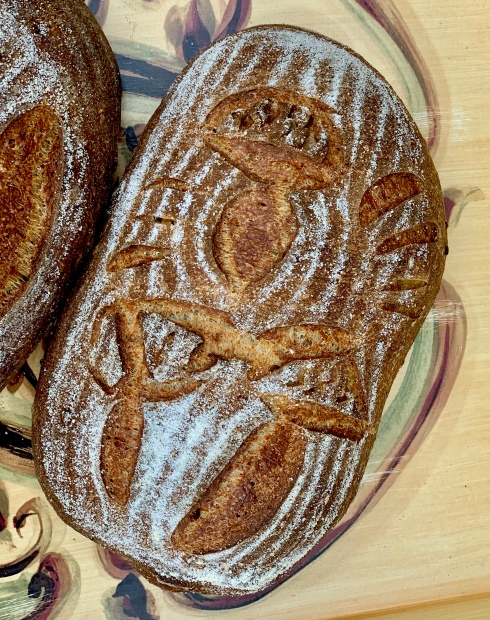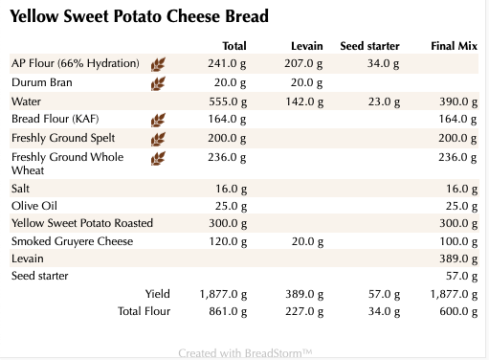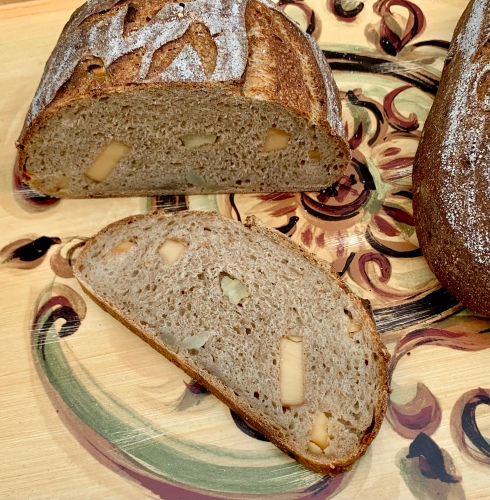
The whole wheat was milled and sifted twice using my MockMill 200 and a #30 and #40 drum sifter. The spelt I sifted once using the #30 and re-milled the second time on the finest setting with the stones just starting to touch. This really gives you a nice fine flour that’s not gritty at all.
I decided to add some cheese to the levain to change things up a bit. I’m not sure if it helped or hindered anything but the cheese flavor certainly is nice and pronounced throughout the bread. I added cubed cheese to the main dough since I wanted to really get some nice chunks in each slice. You could certainly grate the cheese and add it that way and it still will be tasty.
The final dough ended up sitting in the refrigerator for over 36 hours since I ended up getting called into work on Saturday expectantly so I wasn’t able to bake the bread until today, Sunday morning. The dough seemed to hold up pretty well all things considering. It may have been a tad over fermented but the crumb was okay and the flavor was excellent. This will make a great sandwich and go along with




Levain Directions
Mix all the levain ingredients together for about 1 minute and cover with plastic wrap. Let it sit at room temperature for around 7-8 hours or until the starter has doubled. You can use it immediately in the final dough or let it sit in your refrigerator overnight.
Main Dough Procedure
After milling your flours add the starter to the water in the bowl of your mixer and break it up. Reserve about 30-50 grams of water to add after the autolyse.
Mix the flour with the water and starter for a minute and mix until just incorporated. Cover the dough and let it sit at room temperature for 30-60 minutes. Next add the rest of the ingredients and mix on low for 12 minutes (I use an Ankarsum mixer but if using a different mixer I would suggest mixing for around 4-5 minutes). Note: If your dough is not too wet add as much of the reserved water or more as needed.
Remove the dough from your bowl and place it in a lightly oiled bowl or work surface and do several stretch and folds. Let it rest covered for 10-15 minutes and then do another stretch and fold. Let it rest another 10-15 minutes and do one additional stretch and fold. After a total of 2 hours place your covered bowl in the refrigerator and let it rest for 12 to 24 hours. (Since I used my proofer set to 79 degrees F. I only let the dough sit out for 1.5 hours before refrigerating).
When you are ready to bake remove the bowl from the refrigerator and let it set out at room temperature still covered for 1.5 to 2 hours. Remove the dough and shape as desired.
The dough will take 1.5 to 2 hours depending on your room temperature and will only rise about 1/3 it’s size at most. Let the dough dictate when it is read to bake not the clock.
Around 45 minutes before ready to bake, pre-heat your oven to 540 degrees F. and prepare it for steam. I have a heavy-duty baking pan on the bottom rack of my oven with 1 baking stone on above the pan and one on the top shelf. I pour 1 cup of boiling water in the pan right after I place the dough in the oven.
Right before you are ready to it in the oven, score as desired and then add 1 cup of boiling water to your steam pan or follow your own steam procedure.
Lower the temperature to 450 degrees. Bake for 35-50 minutes until the crust is nice and brown and the internal temperature of the bread is 205 degrees.
Take the bread out of the oven when done and let it cool on a bakers rack before for at least 2 hours before eating.

- Isand66's Blog
- Log in or register to post comments
These look delicious Ian, I’m amazed that the cheese didn’t melt during the bake!
Benny
I was surprised it stayed so solid. I did use some pretty big chunks😁
Happy Baking!
Ian
Is what the recipe says but I may need some help with the hieroglyphics interpretation. I have been reluctant to do a second pass through my Mockmill because the instructions cautioned against that. Have you experienced any issues like overheating or glazing on the stones?
Nice bake and it was helpful for me to see that the longer time spent in the fridge had no effect on the bread.
Don
Never heard anything about having negative effects doing a second pass in the mill. I certainly have not and I know a lot of people do this so go for it. I mill first pass without the stones touching, sift using a #30 drum sieve and then remill with the stones touching. I then sift again with a #40. Sometimes I only sift once with the 30.
Hope that helps. It’s fun to experiment and see what you like best…